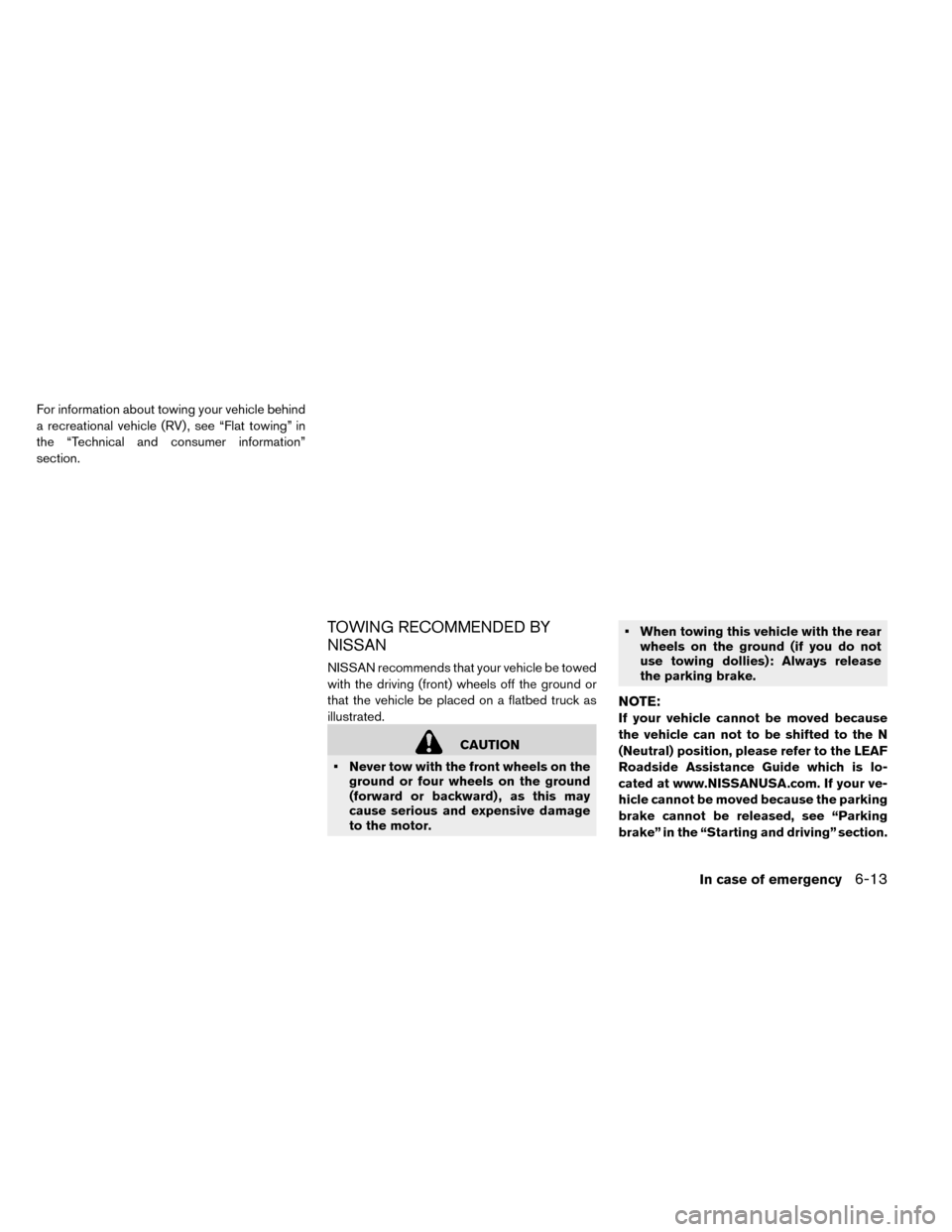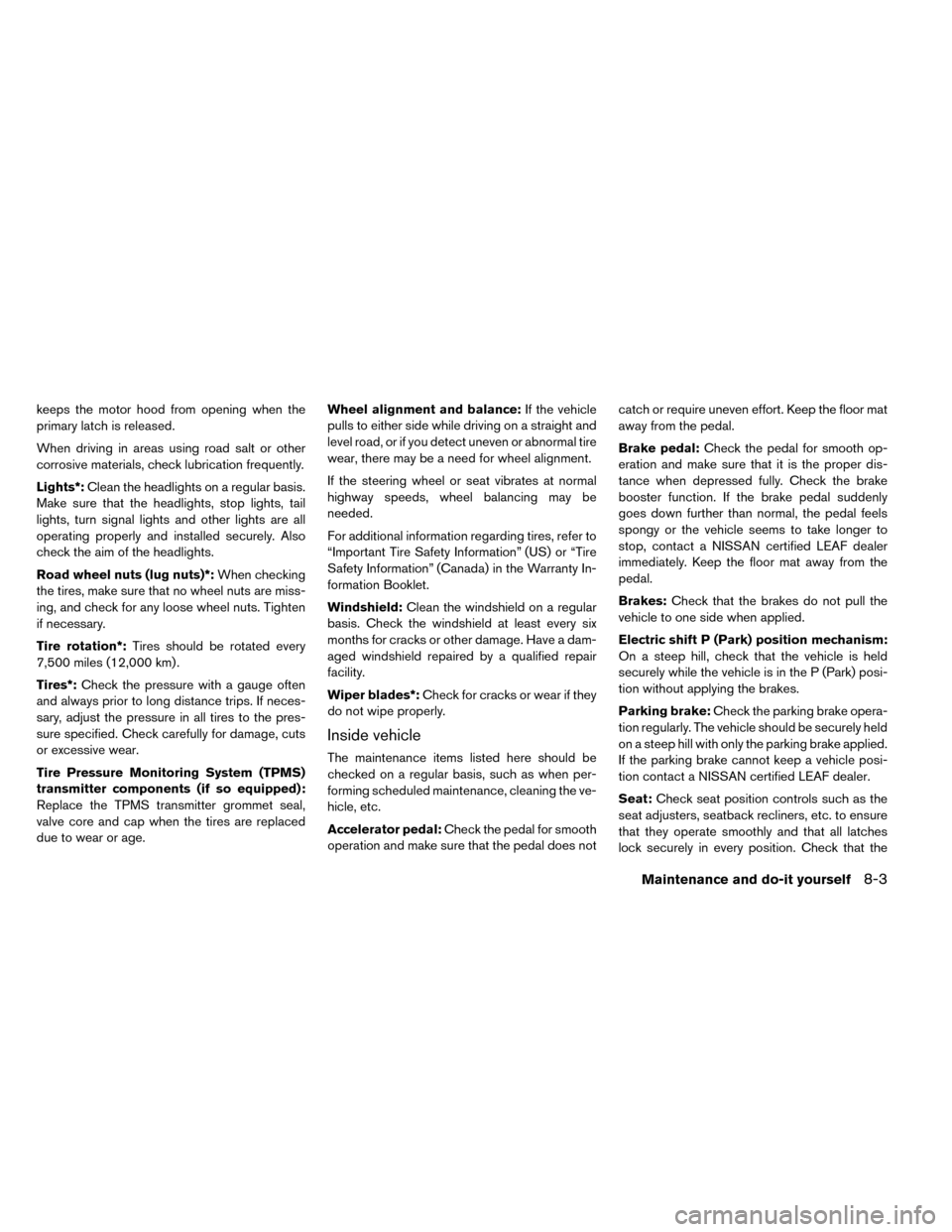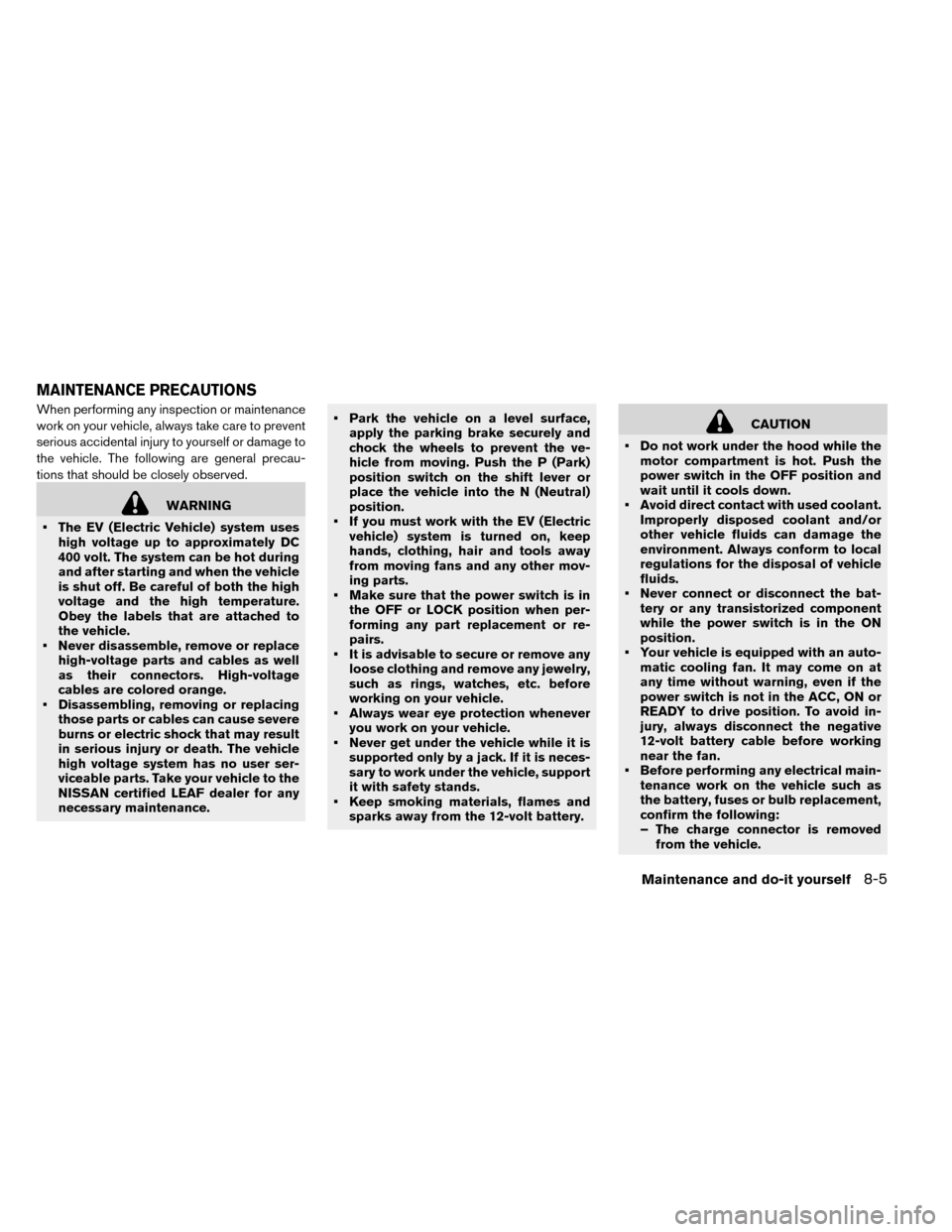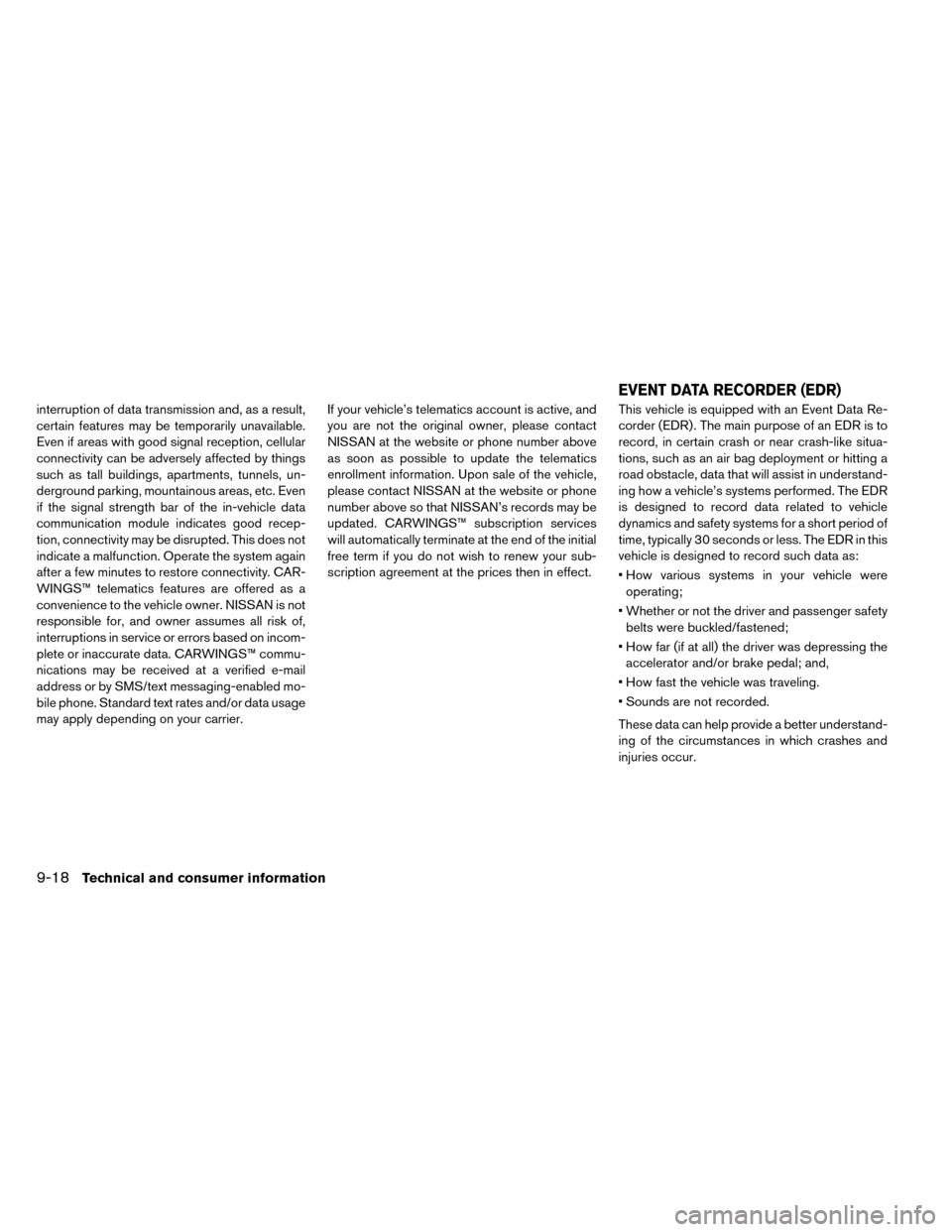2015 NISSAN LEAF parking brake
[x] Cancel search: parking brakePage 328 of 412

For information about towing your vehicle behind
a recreational vehicle (RV) , see “Flat towing” in
the “Technical and consumer information”
section.
TOWING RECOMMENDED BY
NISSAN
NISSAN recommends that your vehicle be towed
with the driving (front) wheels off the ground or
that the vehicle be placed on a flatbed truck as
illustrated.
CAUTION
• Never tow with the front wheels on the ground or four wheels on the ground
(forward or backward) , as this may
cause serious and expensive damage
to the motor. • When towing this vehicle with the rear
wheels on the ground (if you do not
use towing dollies): Always release
the parking brake.
NOTE:
If your vehicle cannot be moved because
the vehicle can not to be shifted to the N
(Neutral) position, please refer to the LEAF
Roadside Assistance Guide which is lo-
cated at www.NISSANUSA.com. If your ve-
hicle cannot be moved because the parking
brake cannot be released, see “Parking
brake” in the “Starting and driving” section.
In case of emergency6-13
Page 342 of 412

keeps the motor hood from opening when the
primary latch is released.
When driving in areas using road salt or other
corrosive materials, check lubrication frequently.
Lights*:Clean the headlights on a regular basis.
Make sure that the headlights, stop lights, tail
lights, turn signal lights and other lights are all
operating properly and installed securely. Also
check the aim of the headlights.
Road wheel nuts (lug nuts)*: When checking
the tires, make sure that no wheel nuts are miss-
ing, and check for any loose wheel nuts. Tighten
if necessary.
Tire rotation*: Tires should be rotated every
7,500 miles (12,000 km) .
Tires*: Check the pressure with a gauge often
and always prior to long distance trips. If neces-
sary, adjust the pressure in all tires to the pres-
sure specified. Check carefully for damage, cuts
or excessive wear.
Tire Pressure Monitoring System (TPMS)
transmitter components (if so equipped):
Replace the TPMS transmitter grommet seal,
valve core and cap when the tires are replaced
due to wear or age. Wheel alignment and balance:
If the vehicle
pulls to either side while driving on a straight and
level road, or if you detect uneven or abnormal tire
wear, there may be a need for wheel alignment.
If the steering wheel or seat vibrates at normal
highway speeds, wheel balancing may be
needed.
For additional information regarding tires, refer to
“Important Tire Safety Information” (US) or “Tire
Safety Information” (Canada) in the Warranty In-
formation Booklet.
Windshield: Clean the windshield on a regular
basis. Check the windshield at least every six
months for cracks or other damage. Have a dam-
aged windshield repaired by a qualified repair
facility.
Wiper blades*: Check for cracks or wear if they
do not wipe properly.
Inside vehicle
The maintenance items listed here should be
checked on a regular basis, such as when per-
forming scheduled maintenance, cleaning the ve-
hicle, etc.
Accelerator pedal: Check the pedal for smooth
operation and make sure that the pedal does not catch or require uneven effort. Keep the floor mat
away from the pedal.
Brake pedal:
Check the pedal for smooth op-
eration and make sure that it is the proper dis-
tance when depressed fully. Check the brake
booster function. If the brake pedal suddenly
goes down further than normal, the pedal feels
spongy or the vehicle seems to take longer to
stop, contact a NISSAN certified LEAF dealer
immediately. Keep the floor mat away from the
pedal.
Brakes: Check that the brakes do not pull the
vehicle to one side when applied.
Electric shift P (Park) position mechanism:
On a steep hill, check that the vehicle is held
securely while the vehicle is in the P (Park) posi-
tion without applying the brakes.
Parking brake: Check the parking brake opera-
tion regularly. The vehicle should be securely held
on a steep hill with only the parking brake applied.
If the parking brake cannot keep a vehicle posi-
tion contact a NISSAN certified LEAF dealer.
Seat: Check seat position controls such as the
seat adjusters, seatback recliners, etc. to ensure
that they operate smoothly and that all latches
lock securely in every position. Check that the
Maintenance and do-it yourself8-3
Page 344 of 412

When performing any inspection or maintenance
work on your vehicle, always take care to prevent
serious accidental injury to yourself or damage to
the vehicle. The following are general precau-
tions that should be closely observed.
WARNING
• The EV (Electric Vehicle) system uses high voltage up to approximately DC
400 volt. The system can be hot during
and after starting and when the vehicle
is shut off. Be careful of both the high
voltage and the high temperature.
Obey the labels that are attached to
the vehicle.
• Never disassemble, remove or replace high-voltage parts and cables as well
as their connectors. High-voltage
cables are colored orange.
• Disassembling, removing or replacing those parts or cables can cause severe
burns or electric shock that may result
in serious injury or death. The vehicle
high voltage system has no user ser-
viceable parts. Take your vehicle to the
NISSAN certified LEAF dealer for any
necessary maintenance. • Park the vehicle on a level surface,
apply the parking brake securely and
chock the wheels to prevent the ve-
hicle from moving. Push the P (Park)
position switch on the shift lever or
place the vehicle into the N (Neutral)
position.
• If you must work with the EV (Electric vehicle) system is turned on, keep
hands, clothing, hair and tools away
from moving fans and any other mov-
ing parts.
• Make sure that the power switch is in the OFF or LOCK position when per-
forming any part replacement or re-
pairs.
• It is advisable to secure or remove any loose clothing and remove any jewelry,
such as rings, watches, etc. before
working on your vehicle.
• Always wear eye protection whenever you work on your vehicle.
• Never get under the vehicle while it is supported only by a jack. If it is neces-
sary to work under the vehicle, support
it with safety stands.
• Keep smoking materials, flames and sparks away from the 12-volt battery.
CAUTION
• Do not work under the hood while the motor compartment is hot. Push the
power switch in the OFF position and
wait until it cools down.
• Avoid direct contact with used coolant. Improperly disposed coolant and/or
other vehicle fluids can damage the
environment. Always conform to local
regulations for the disposal of vehicle
fluids.
• Never connect or disconnect the bat- tery or any transistorized component
while the power switch is in the ON
position.
• Your vehicle is equipped with an auto- matic cooling fan. It may come on at
any time without warning, even if the
power switch is not in the ACC, ON or
READY to drive position. To avoid in-
jury, always disconnect the negative
12-volt battery cable before working
near the fan.
• Before performing any electrical main- tenance work on the vehicle such as
the battery, fuses or bulb replacement,
confirm the following:
– The charge connector is removedfrom the vehicle.
MAINTENANCE PRECAUTIONS
Maintenance and do-it yourself8-5
Page 393 of 412

interruption of data transmission and, as a result,
certain features may be temporarily unavailable.
Even if areas with good signal reception, cellular
connectivity can be adversely affected by things
such as tall buildings, apartments, tunnels, un-
derground parking, mountainous areas, etc. Even
if the signal strength bar of the in-vehicle data
communication module indicates good recep-
tion, connectivity may be disrupted. This does not
indicate a malfunction. Operate the system again
after a few minutes to restore connectivity. CAR-
WINGS™ telematics features are offered as a
convenience to the vehicle owner. NISSAN is not
responsible for, and owner assumes all risk of,
interruptions in service or errors based on incom-
plete or inaccurate data. CARWINGS™ commu-
nications may be received at a verified e-mail
address or by SMS/text messaging-enabled mo-
bile phone. Standard text rates and/or data usage
may apply depending on your carrier.If your vehicle’s telematics account is active, and
you are not the original owner, please contact
NISSAN at the website or phone number above
as soon as possible to update the telematics
enrollment information. Upon sale of the vehicle,
please contact NISSAN at the website or phone
number above so that NISSAN’s records may be
updated. CARWINGS™ subscription services
will automatically terminate at the end of the initial
free term if you do not wish to renew your sub-
scription agreement at the prices then in effect.
This vehicle is equipped with an Event Data Re-
corder (EDR) . The main purpose of an EDR is to
record, in certain crash or near crash-like situa-
tions, such as an air bag deployment or hitting a
road obstacle, data that will assist in understand-
ing how a vehicle’s systems performed. The EDR
is designed to record data related to vehicle
dynamics and safety systems for a short period of
time, typically 30 seconds or less. The EDR in this
vehicle is designed to record such data as:
• How various systems in your vehicle were
operating;
• Whether or not the driver and passenger safety belts were buckled/fastened;
• How far (if at all) the driver was depressing the accelerator and/or brake pedal; and,
• How fast the vehicle was traveling.
• Sounds are not recorded.
These data can help provide a better understand-
ing of the circumstances in which crashes and
injuries occur.
EVENT DATA RECORDER (EDR)
9-18Technical and consumer information
Page 401 of 412

Lock........................3-5
Automatic door locks .............3-5
Door locks ...................3-3
Power door lock ................3-3
Rearhatchlock................3-18
Low tire pressure warning light .........2-16
Low tire pressure warning system (See tire
pressure monitoring system (TPMS)) ......5-2
Luggage side hook ...............2-54
M
Maintenance...................8-11
12-volt battery ................8-11
Generalmaintenance .............8-2
Indicatorsformaintenance..........2-34
Inside vehicle ..................8-3
Maintenance precautions ...........8-5
Maintenance requirements ..........8-2
Outside vehicle .................8-2
Seatbeltmaintenance............1-15
Manual front seat adjustment ...........1-3
Maplights ....................2-57
Mechanical key (Intelligent Key system) .....3-3
Meters and gauges ................2-5
Mirror .......................3-23
Inside rearview mirror.............3-23
Outside mirrors ................3-24
Vanity mirror ..................3-22
Motor....................5-10,9-5 Before starting system
............5-10
Motor compartment ................8-7
N
NISSAN Intelligent Key® system ......3-6,5-7
Key operating range of the door lock/unlock
function.....................3-8
Key operation ..................3-9
NISSAN Vehicle Immobilizer System ......2-37
Normalcharge..................CH-9 Home charge ................CH-9
Occasional charge .............CH-9
Publiccharge ................CH-9
O
Odometer .....................2-6
Off-road recovery .................5-5
Oil .........................9-2 Recommended fluids/lubricants and
capacities ....................9-2
Opening rear hatch ...............3-10
Outside air temperature .............2-10
Outside mirrors .................3-24
Owner’s Manual/Service Manual order
information ....................9-19
P
Panic alarm....................3-14
Parking ......................5-15
Parking on hills ................5-18
Parking brake break-in ..............5-21
Power .......................3-3 Power door lock ................3-3
Power steering system ............5-19
Power windows ................2-55
Powereconomy.................5-17
Powermeter....................2-7
Power outlet ...................2-49
Power steering system .............5-19
Powerswitch.................5-7,5-8
Precautions ....................5-20
Brake precautions ..............5-20
Charging ...................CH-2
Child restraints ................1-18
Cruise control .................5-15
High voltage precautions ..........EV-7
Maintenance..................8-5
Road accident precautions .........EV-8
Seatbeltusage ................1-8
Supplemental restraint system........1-36
When starting and driving ...........5-2
Push starting ...................6-12
10-4Technical and consumer information